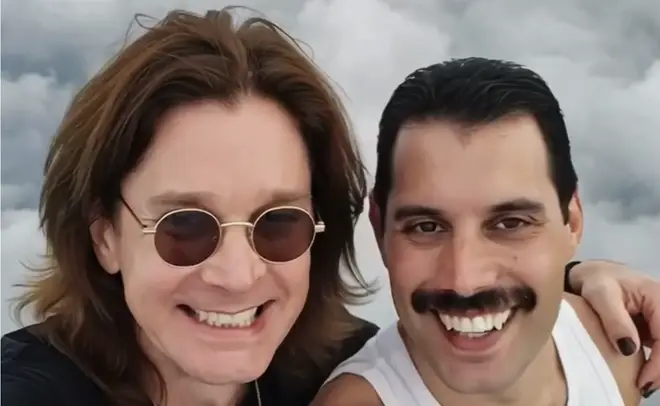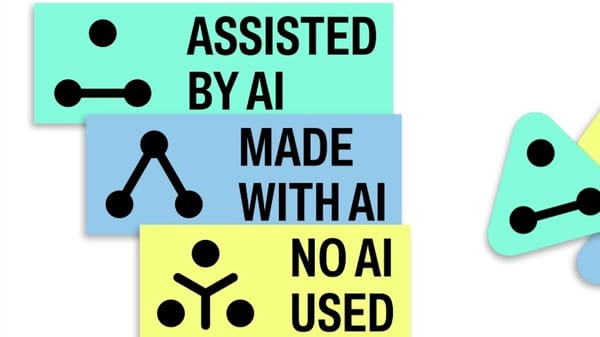The Rod Stewart AI Tribute Controversy: When Technology Outpaces Taste

This summer, as Rod Stewart's "One Last Time" tour wound through American amphitheatres, something unprecedented happened during his nightly dedication of "Forever Young" to his late friend Ozzy Osbourne. What began as a touching tribute evolved into something far more controversial, and revealing about our relationship with generative Ai.
The story is simple. Since Osbourne's death on July 22, Stewart had been dedicating his hit song "Forever Young" to the Black Sabbath frontman at shows along his tour, conventionally singing the sentimental ballad with images of Osbourne projected behind him in an affectionate tribute. But at his 1st August concert outside Atlanta, the tribute took an unexpected turn.
The images started as standard shots of Osbourne, but eventually evolved into AI-generated visuals of the rocker posing with the likes of Prince, Tina Turner, Bob Marley, Freddie Mercury, Kurt Cobain, George Michael and Amy Winehouse, all standing on cloudy and celestial backdrops to suggest a heavenly afterlife. Picture-perfect digital resurrection, complete with selfies and smiles.
The reaction was swift and overwhelmingly negative.
The Backlash: More Than Just Technology Criticism
The tribute was criticized as disrespectful and bizarre by fans and media alike, with social media erupting in criticism. One concert-goer called it "the craziest most disrespectful s–t I ever saw," while others used terms like "weird," "sick," and "distasteful." The tribute left fans divided, but the division was heavily weighted toward disapproval.
This wasn't a rejection of new technology. The negative response tells us something deeper about the intersection of AI capabilities and human sensibilities. As generative AI technologies increase in quality, the questions we face are no longer just about whether something can be done, but whether it should be done. As technical barriers dissolve, we are left to grapple with questions of taste, design, appropriateness, legality, and respect.
Rod Stewart's AI tribute represents a case study in this new reality. There's no question that Stewart cared deeply for Osbourne. As his friend, on the day of Osbourne's death, Stewart posted on Instagram, stating, "Bye, bye Ozzy. I'll see you up there…later rather than sooner." The AI application was, we can only assume, created and approved from a place of love and respect. He was his friend, and he wanted to create a tribute that was special. Yet fans, critics, and the press didn't necessarily see it that way.
Why "Disrespectful" Became the Defining Word
The word "disrespectful" appeared repeatedly in coverage and commentary, and it's worth examining why this became the instinctive response. Several factors likely contribute to this gut reaction:
The tragedy of premature death: Many of these musicians died tragically, often younger than they should have. At a show in Charlotte, Stewart ended the song saying, "Very sad. A lot of those people died 'cause of drugs… I'm still here, though!" Picturing them smiling and happy in a vision imposed upon them creates a strange juxtaposition with their often tragic ends. The cheerful AI-generated afterlife felt disconnected from the reality of their struggles.
The question of consent: The photorealistic quality of these AI images raised immediate questions about approval. To our knowledge, these representations weren't approved by the deceased artists' estates. When someone dies, their image becomes particularly precious to those left behind. If people suspect these images were produced without estate agreement, it fundamentally affects their perception of the work as disrespectful to families and legacies.
Religious and spiritual sensitivities: The depiction of a casual, social-media-friendly "heaven" may have struck some as too flippant for such weighty subject matter. The image of deceased icons taking selfies in paradise carried an inherent frivolity that many found jarring.
Legal experts have noted that celebrities have a right to control the commercial use of their name, image, and likeness, meaning they can prevent others from using their identity for profit-making purposes without consent. While Stewart may have intended this as tribute rather than commercial exploitation, including it as part of a paid show creates a gray area that makes many uncomfortable.
The Treatment Matters: When Art Becomes Artifice
Here's a thought experiment: What if this sequence had been rendered not as photorealistic AI-generated imagery, but as animated sketches or artistic interpretations? I suspect the reaction would have been markedly different. Not necessarily positive, but likely more sympathetic.
When something is evidently artistic in its treatment, audiences grant it different permissions. We accept stylized, interpretive representations in ways we don't accept what appears to be documentary-level recreation. The uncanny perfection of AI-generated imagery creates an expectation of authenticity that artistic interpretation doesn't necessarily carry.
The problem lies partly in the technology's very success. These images were too good, too convincing, too real. They crossed from tribute into something that many felt like impersonation or unauthorised representation. It will be interesting to see how (and if) perceptions like this change over time as creative generative techniques become more embedded in culture.
The Speed of Creation vs. The Need for Reflection
Another interesting aspect of this controversy is what it reveals about our decision-making processes in the AI era. Somewhere in the planning for this tribute, someone likely had an exciting realisation: "I know what we could do as a tribute to Ozzy! This would be amazing! All those wonderful artists who have passed away! What if they were all in heaven having a blast together! Wouldn't it be cool to show that!"
The enthusiasm is understandable. The technology makes such visions not just possible but relatively easy to execute. But that's precisely the problem. The ease with which these images can now be produced means that consideration of approval, design, appropriateness, and impact can happen too quickly, without the natural pause that a more costly and complicated project would enforce.
In the past, creating such a sequence would have required significant time, money, and multiple people. There would have been natural checkpoints such as budget approvals, production meetings, review processes - within which someone might have asked the crucial question: "Hold on a minute, is this the right thing to do? Is it respectful? Should we do this?"
AI has compressed that timeline dramatically. In the main, this can be an amazing, creative and democratising thing. An idea can become reality with remarkable speed. But, it can now outpace our ability to fully consider its implications.
A New Responsibility
This doesn't mean we should retreat from creative innovation with Ai. But it does mean we need to impose some new processes on ourselves. The technology is evolving faster than our collective wisdom about its application.
As AI capabilities continue to advance, we'll face countless similar moments. Opportunities to create things that were previously impossible, depicting people and scenarios with unprecedented realism. The question isn't always about whether we should use these tools, but how we should use them responsibly.
The Rod Stewart controversy offers several lessons: Consider the context and treatment of your AI creations. Think about consent and representation, especially when dealing with deceased individuals whose estates may have strong feelings about their legacy. Recognise that photorealistic recreation might carry different moral weight than obvious artistic interpretation. Most importantly, build deliberation into the creative process, even when (perhaps especially when) the technology makes instantaneous creation possible.
We need grown-ups in the room to pause and ask the hard questions before pressing the prompt. The technology will only get more powerful; our responsibility is to ensure our judgment keeps pace.
In the end, Rod Stewart's AI tribute to Ozzy Osbourne wasn't a failure of technology. It was a reminder that technology alone isn't enough. As we navigate this new technical landscape, the most human qualities - taste, empathy, respect, wisdom - become more important than ever. The machine can create the image, but only we can decide whether it should exist.




